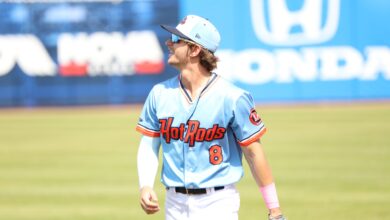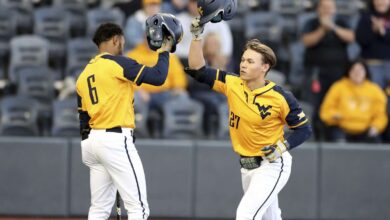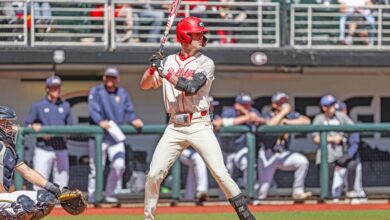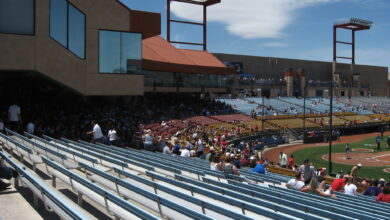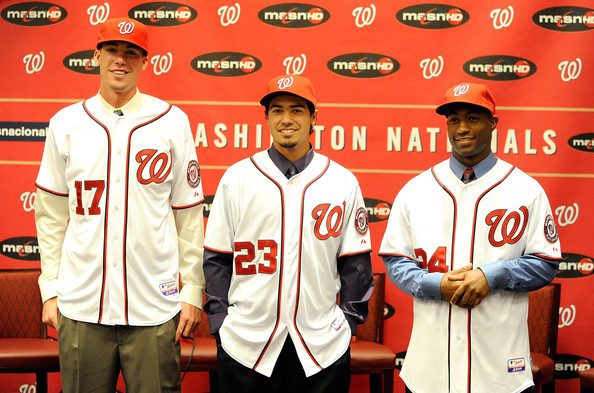

The most sustainable way to win in Major League Baseball is to do so with a steady stream of homegrown players. Teams draft and sign talented amateur players, develop them until they’re ready to contribute at the major-league level and then reap the benefits while those players remain employed for a fraction of what they’re actually worth. This starts a financial cycle in which the players (mostly by winning) collectively generate revenue that exceeds the payroll. The team makes a ton of money, ideally reinvests it in the roster and voila, a juggernaut is born. It’s clear this is where the Washington Nationals are heading. After an expensive, aggressive 2011 draft, Washington has a farm system filled to the brim with talent. Below, I do my best to profile the more prominent members of that system — good, bad, overrated, sleepers, everything — in no particular order.
Matt Purke (LHP) — Purke was a much-talked-about amateur prospects early in his career at TCU. Arm troubles caused a dip in his velocity and a subsequent drop in the 2011 draft. That Nats took a flier on him and sent him to the Arizona Fall League as he begins to recapture the form from his freshman year as a Horned Frog. The results have not been encouraging. When I saw him in Surpise for his first start, Purke was leaving lots of pitches up in the zone (when he could find the zone at all) that were spanked into gaps, his fastball velocity was still in recovery and he had no feel for his secondary pitches (slider and changeup). His release point was the most inconsistent I’ve ever seen from a professional. It doesn’t make sense to draw finite conclusions about Purke’s long-term viability until at least next spring when he’s had a full winter to shake off what is clearly a mountain of rust. After the dumpster fire I saw this fall, I’m not exactly optimistic.
Sammy Solis (LHP) – A second-round selection in 2010 out of The University of San Diego, Solis was another AFL prospect I had the pleasure of scouting. The towering lefty boasts a three-pitch mix consisting of a mid-70s knuckle curve which he’s still trying to master, a low-90s fastball that was showing more velo in the AFL than is typical for Solis, and a true plus change-up with great fade and arm side action. His lower half is stiff and lazy during his delivery but there’s nothing about the arm action that screams, “I’m going to get hurt.” One cool things about Solis is, despite his size, his pop times from the stretch are above average, so he won’t be abused by the running game like so many guys of similar stature have been before him. The prognosis on Solis is one of a mid-rotation starter, but if the uptick in velocity he showed in the Fall League holds, that ceiling would need to be reconsidered. Since Fall Leaguers only throw around three innings per start, they can let it rip without having to worry about maintaining their stamina for 6+ innings. So, that might be why his velocity has spiked.
Pat Lehman (RHP) – A 13th-round selection out of George Washington University in the 2009 draft, Lehman has a shot to be a decent bullpen arm. The 25-year-old, fast-working righty has some above-average secondary stuff that’ll play in the majors. While Lehman’s fastball is a little fringy, his changeup is above average and his command of a two-plane slider makes up for the fact that it’s a little short. He reached double-A Harrisburg in 2011, so he’s a little behind schedule as far development goes.
Rafael Martin (RHP) – Martin was signed out of Mexico as a 25-year-old in 2010. He’s now 27 and, after a strong performance in double-A, he needs to be given a shot in the majors at some point this season so we can find out exactly what the Nats have here. Martin works with a 91-93 mph fastball that easily plays above average thanks to its sink. He has a hard, upper-80s slider and a fringy changeup. He might be left in Syracuse as spring training breaks, but he’ll likely be one of the first arms up should someone get hurt or traded.
Steve Lombardozzi (INF) – Lombardozzi is nearly major-league ready (when I say that, it’s a nice way of saying he has no projection remaining) and will have some value simply because he can play shortstop in a pinch. He’d be a below-average starter, even as a second baseman, but is a better hitter than Ian Desmond. In my opinion, it’d be a net positive to move Danny Espinosa to short and start Lombardozzi at second base until a better option arrives, either from within the organization or otherwise.
Bryce Harper (OF) – There are only two players in all of baseball that I’m comfortable handing a grade of 80 for raw power. Harper is one of them. I can’t decide what I’m most impressed with, Harper’s raw abilities or how advanced he is for a hitter his age. Having just turned 19 years old a month or so ago, Harper’s already made it to double-A, and had two stints in the Arizona Fall League.
Everyone who has seen Harper a few times has some kind of story to tell. It might be some freakish batting-practice bomb he launched into the batter’s eye or a throw he made on the fly to third base from the warning track. Mine comes from this year’s AFL. Harper was facing the 2011 draft’s first overall selection, Gerrit Cole. Cole tried to blow a 99 mph fastball past Harper on the inner half of the plate. Harper, without cheating on it, opened his hips, got the bat head on the ball and ripped a screamer into right field. For a teenager to react on the fly to that kind of velocity and make high-quality contact is awe inducing.
The one thing to look for Harper to tinker with is the effort in his swing. He goes full bore with each hack which may lead to more swing and miss than you’d like. In a related matter, Harper’s two-strike approach is nonexistent. These are things that should come as he continues to mature at the plate. Defensively, Harper has a plus arm that plays as average due to accuracy issues. I’ve had times from home to first for him in the 4.2s, which is average for a left-handed hitter, and he might, might, be worth a try in center field for the short term. I don’t think he’d stick there for the long haul, but it would do wonders for his value until he filled out, got a bit slower, and forced the Nats to move him to an outfield corner. He might have more than one MVP award on his mantle by the end of his career.
Derek Norris (C) – Whenever you’re talking about a catching prospect, the first question you need to ask is “can he stick behind the plate?” Thanks to a terrific arm and acceptable receiving skills, Norris likely can. He still needs work on game calling and blocking balls in the dirt, but the 21-year-old still has time to develop the first of those two skills. His thick, slow frame (that’s putting it nicely) precludes him from vacuuming up pitches in the dirt. Offensively, Morris is a bit on an enigma. In 2011 he hit just .210 but had a .367 OBP and slugged .446. He’s had similar stat lines during much of his career, prompting more than one Mickey Tettleton comparison. I think Norris will push Wilson Ramos for the starting catcher spot in 2013 and may be a trade piece in the interim. Be aware that I like Norris more than most, mostly because I’m more confident in his viability as a long-term catcher. But, if Norris gets noticeably bigger and has to move out from behind the plate, then we have a serious problem.
Chris Marrero (1B) – After a trial run in the outfield, the Nationals have moved Marrero back to first base. He’s improved there and is now above-average defensively for a first baseman. He might hit enough to play every day, but I don’t feel good about it. There’s lots of noise in a swing that is long to begin with, and he looks to me like a guy who might strike out in 25 percent of his plate appearances. For me, he’s a decent bench bat.
Anthony Rendon (3B/2B) – An advanced approach, terrific bat speed and a great swing path make Rendon a very advanced prospect who is probably going to push his way to the majors by late 2012. He battled injuries that kept him relegated to DH duties during his 2011 season at Rice, but when he’s healthy enough to play third base, he’ll be plus there with a well-above-average arm and quick reactions. The fact that Rendon’s bat is likely to move him through the minors quickly means he may initially be tried at second base, so both he and Ryan Zimmerman can be worked into the same lineup. We’ll have to see if he has the range to play up the middle and if his small, potentially injury-prone frame can withstand the beating middle infielders routinely take.
Brian Goodwin (OF) – It’s not often potential five-tool players fall toward the sandwich round but Goodwin did in the 2011 draft. Goodwin can really fly and has the physical ability to play centerfield, though he needs to get better at reading the ball off the bat and he often takes inefficient, circuitous routes. Offensively, Goodwin has a good eye, fine bat speed and, in a perfect world, could fill out and hit for above-average power. He gets his weight out on his front foot too often during his swing, so look for that mechanical correction this spring.
A.J. Cole (RHP) – Cole is a long way away from Washington, but the potential is there for a front line starter. His 6’-5”, 180 lb frame gives him plenty of room to fill out, add stamina and maybe velocity. Adding velocity to a fastball that already regularly touches the mid-90s sounds like fun. He has a nice feel for a changeup but really needs to find a breaking ball. He’s a very talented project that could reach double-A in 2012.
Brad Peacock (RHP) – Peacock opened eyes in 2011 by torching the Eastern League to the tune of a 2.01 ERA and 12 K/9 in about 100 innings. There’s dissenting opinion about whether or not he can stick in a rotation, not because of stuff but because of issues with Peacock’s high-effort delivery and smallish frame. Peacock’s three-pitch mix includes an above-average fastball, average change-up and curveball. I’m more comfortable with him pitching in relief, but I understand that he’d be three times as valuable as a starter. He should be given a chance to start and left there until he proves he shouldn’t be. It’s not like Washington can’t afford to take a chance and make a mistake here, they’re not going to contend in 2012 anyway. Give Peacock the chance to start, if he’s bad or gets hurt, then move him to the bullpen. He’ll have plenty of time to recover from any setbacks by the time Washington contends.
Alex Meyer (RHP) – Another guy who may not stick in a rotation, Meyer is so freaking big (6’-9”) that he has trouble repeating his arm slot, leading to lapses in control. He has two plus pitches, a mid-90s running fastball that touches 99 mph and a vicious slider in the 82-86mph range. Despite that stuff, Meyer didn’t perform well in college. Meyer is the epitome of a boom or bust prospect. He has two things to work on. For one, he needs to develop a way to get lefties out. Whether that’s developing a changeup/splitter or learning to work his slider in the back door and back foot to lefties doesn’t matter, just figure it out. Second, the control and command need work. If Meyer does both of those things, he’s a number-one starter. If he does one, he’s a stud reliever. If he does neither, he’ll be updating his resume by 2015.
After 2,000 words, I’d say we’ve both had enough. Hopefully, you’ve got a better idea of what to expect from one of the better farm systems in all of baseball.


